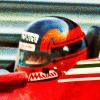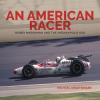How do you end up with a scheme like that in the first place? 
Tradition!
The idea was to reward teams and drivers who were `ready` early in the month with the opportunity to start up front.
But do you know what was actually far more funny? How the assignent in which order drivers were permitted to go out for qualifying was settled!
Initially it was a matter of trhe first who presents his car for qualifying is permitted to go. Which resulted is a mad dash to the qualifying line in order to get an early spot and thus the chance to qualify on the first day. because in case of rain interferering, you could end up looising the chance to qualify as a first day qualifier.
It was by the way Colin Chapman who was involved with the end of that habit. In '63 he had missed out on getting a good early spot to qualify, complained and he was told that this was the way it was at indy and `shut up`.
But there were more people feeling this method was a bit too unorganized and then they introduced: `the draw`
After end of practice on the Friday, the day before Pole day, all teams send a representative to a meeting held under the tower. An official held in his had a bag with numbered beans and each team then had one representative pulling a pea out of the bag and the numbers on those beans determined the sequence in which drivers were send off to quailfy. or in Indy terms: the numbers of the qualifying line.
Another improvement with that was the following. Initially it was that had a driver missed out an attempt on pole day due to weather, bad luck brother, come back tomorrow for 2nd day qualifying. But with the qualifying line determined a new rule came, being; If the weather made it impossible to give every car for which a number was drawn a qualifying attempt, then the remaining cars were given a garuanteed attempt to qualify as First day qualifier and thus eliglble for the Pole at the first opportunity, whenever that might be.
The most extreme case of that scenario I can recall is 1990. Friday May 11th had been fine weather, great speeds, Jim Crawford gone up 6 feet high up in the air, a qualifying line drawn and the following Saturday Pole day was rained out. The following Sunday was also rainy but some practice could take place and about 16;00 hours 4 pm qualifying started but everyone knew that it was impossible to have everyone finishing his guaranteed attempt. So at 6 pm when qualifying was over there were some 11 cars left that still had ther shotr for the pole but had to wait till next weekend, Fittipaldi and Rick Mears had been the two fastest cars but the danger for them was that was it much better `faster` weather next weekend they could still loose their front row positions. Al Unser jr, who had been the fastest car of the month had yet to wait for next week, as were Arie Luyendijk and AJ Foyt.
These three and the other drivers not yet qualified then had to deal with the fact that, apart from working on a car setup to qualify, they also had to work on a setup for the race! They had a busy week compared with the already qualified drivers.
One week later the weather wasn't as good as the week before but Luyendijk surprised everyone with a great run to the 3rd qualifying place and every American at the Speedway "knew" that Foyt and Unser jr were better then Arie so they would go for the pole! No way....
Turned out that Arie was the only driver capable of qualifying faster than 221 mph (he was over 223) and had done an exceptionally well performance that day. Little did we know at that time that one week later he would do the same in the race.
I was there in 1990 and saw it all happen and though race day is among my best moments ever in life, that third day of qualifying when Arie made it on the front row was till one week later my best ever day at the track. I never forget the sheer disbelief among the American fans how in the hell that Dutchman could have beaten their Unser Jr and (above all the near holy) AJ Foyt.
I mwentioned how in 1991 only 12 cars qualified and the fifth row, qualifying faster than the rows ahead. How could that happen?
Simple.
It started out a perfect day weatherwise but a bit humid. Als fate/luck wanted it, AJ Foyt was the first car to qualify, followed by Randy Lewis. He crashed and it took half an hour to clean up the track. During that half hour however, the weathjer became steaming hot and the track slower. So many drivers broke off theire first qualifying attempt being part of the qualifying line. Many waited for better weather later in the day.
Now, once the qualifying line is finished no-one has a guaranteed qualifying attempt anymore. Then it is a matter of, who makes it, well done, who passes up and is setup by the weather, tough luck man you had your chance.
Back in '91 everyone had had his one garuanteed attempt and only Rick Mears had managed to beat AJ Foyt's time, and Mario was third fastest. There was some practice and all of a sudden the news came in that bad weater was on the way. So a few drivers decided on qualifying now, despite the not so good conditions. One driver send out in time was Emerson Fittipaldi but he was not fast enough to take the pole and Roger Penske was afraid of loosing the pole to either Luyendijk or the two fastest Buick powered cars of Kevin Cogan and Gary Bettenhausen. In the grandstand we could see a monumental cloudburst rushing into the area, all of us talking about how clever Penske had been to have his both cars in the field after all as first day qualifiers and then he called in Fittipaldi and broke off the attempt!!! The next car went out and then the rain came down in such a burst that it was easy to understand that there was no qualifying left anymore that day and the pole decided to Mears. But Fittipaldi could have been in the first row or at least the second row had Penske allowed Fitti to complete his run.
When people talk about bad decisions from Roger Pesnke that costed Fittipaldi dearly somehow, many mention the wave of on the third day of qualifying in '95. But a lesser known one, but bad decision too by Roger was on Pole day in '91. Fittipladi was 3rd fastest in the field of '91 but at the 14th starting spot but he could have been slower, yet higher up on the grid.
Whow, if I think back on those days, Man am I glad that I can say I've been at IMS in the years when qualifying for the field was still an effort of epic proportions!
Henri



















